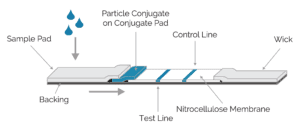Rapid diagnostics test (RDTs)
ü
Rapid diagnostics test also known as Lateral
flow assay.
ü
RDTs are
based on immunochromatographic test.
ü
The tests
are working on ELISA.
ü
RDTs
capture the antigens from the blood sample using monoclonal or polyclonal
antibodies against the antigen targets.
ü
In the RDTs the specific antibody are used for
the detection of specific disease antigen.
How to made RDTs strips:-
ü
In this strip used a laminar pad for specially
made for this strip.
ü
On the laminar pad three types of sticker for
the sample pad, nitrocellulose membrane and absorband pad.
ü
Sample pad are for the put the sample and add on
buffer solution.
Conjugation pad are attached to sample pad that the antibody conjugated.
ü
Nitrocellulose is a main part of the strip, on
the nitrocellulose membrane Antigen-Antibody conjugation site show the result
band.
ü
Absorband pad, Absorbed the all the pass out
sample or buffer etc.
ü
All the strips are fitting plastic cassette.
How to show result that Negative or Positive:
ü
In the RDTs are three types of the markers.
ü
First marker is control line, second is a test
line 1 and third is second test line.
ü
Control line is generally checking for strips
are working or not working.
ü
Second and third line is also checking to the
positive or Negative test.
ü
In the add sample or buffer solution, If the
control line not show colour so that means strip not working .
ü
The control line show colour change and test
line one or second are not colour change so that means result is negative, but
the any one test line appear colour change or both test line colour change
result are Positive.
How RDTs is used:-
ü
We clean the fingertip with an alcohol swab.
ü
We prick the finger with a lancet provided in
the RDTs kit.
ü
Using a capillary pipette/ loop provided, a
blood drop is transferred into the sample well of the device.
ü
Add few drops of buffer solution are added on
the buffer well.
ü
We wait 20 – 25 Min to read the result
Advantages of RDTs:
ü
Easy and quick primary result.
ü
They can take only 20 – 25 min for result
ü
No longer requirement to high performed
technology
ü
Only few drops sample used .
Disadvantages of RDTs:
ü
Not a quantitative method
ü
Only primary test for checking disease.
ü
Sometime issue in the strips, result is
changed
CLICK HERE: https://microbiology0497.blogspot.com/2020/04/coronavirus-what-is-2019-novel.html
CLICK HERE: https://microbiology0497.blogspot.com/2020/04/how-to-boost-your-immunity-power-and.html
CLICK HERE: https://microbiology0497.blogspot.com/2020/05/covid-19-rt-pcr-test_3.html
CLICK HERE: https://microbiology0497.blogspot.com/2020/04/how-to-boost-your-immunity-power-and.html
CLICK HERE: https://microbiology0497.blogspot.com/2020/05/covid-19-rt-pcr-test_3.html

Nice content
ReplyDelete